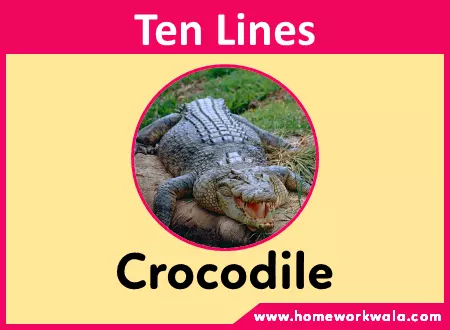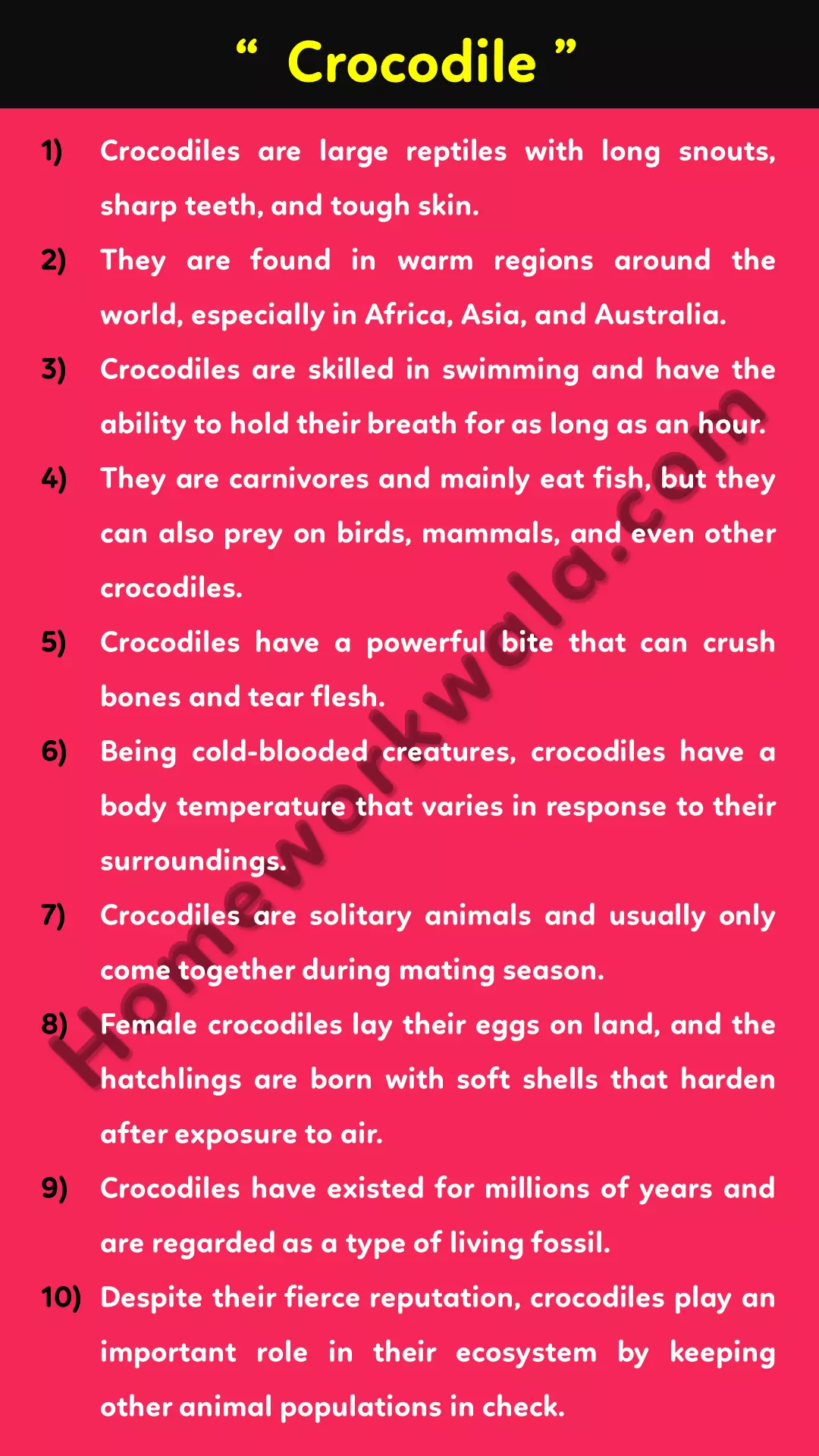Table of Content
Through this article, we are sharing 10 lines on Crocodile in English. This post will help those students who are looking for information about Crocodile in the English Language.
If any student wants to write a short essay on Crocodile then, this post is very useful for them. Information about Crocodile is very simple and easy for writing purposes.
These sentences on Crocodile are very short and easy to understand, so any level of student can write on this topic.

Short essay on Crocodile in English ( In 3 Formats )
Format-1
- Crocodiles are large reptiles with long snouts, sharp teeth, and tough skin.
- They are found in warm regions around the world, especially in Africa, Asia, and Australia.
- Crocodiles are skilled in swimming and have the ability to hold their breath for as long as an hour.
- They are carnivores and mainly eat fish, but they can also prey on birds, mammals, and even other crocodiles.
- Crocodiles have a powerful bite that can crush bones and tear flesh.
- Being cold-blooded creatures, crocodiles have a body temperature that varies in response to their surroundings.
- Crocodiles are solitary animals and usually only come together during mating season.
- Female crocodiles lay their eggs on land, and the hatchlings are born with soft shells that harden after exposure to air.
- Crocodiles have existed for millions of years and are regarded as a type of living fossil.
- Despite their fierce reputation, crocodiles play an important role in their ecosystem by keeping other animal populations in check.
You May Also Like
Format-2
- Crocodiles are very ancient animals that have been on Earth for over 200 million years.
- They can live up to 70 years in the wild, but unfortunately, many species are endangered due to hunting and habitat loss.
- Crocodiles are well adapted to their environment and can regulate their body temperature by basking in the sun or cooling off in the water.
- Crocodiles possess a distinctive third eyelid, known as a nictitating membrane, which shields their eyes while underwater.
- Crocodiles have a keen sense of smell and hearing that helps them locate prey.
- Their skin is covered in bony plates called scutes that act like armor to protect them from predators.
- When they catch their prey, crocodiles use their powerful tails to drag them into the water and drown them.
- Baby crocodiles are called hatchlings and are very vulnerable to predators, including birds and other crocodiles.
- Crocodiles are apex predators, which means they are at the top of the food chain in their ecosystem.
- In some cultures, crocodiles are considered sacred animals and are even worshipped as gods.
Format-3
- Crocodiles have excellent eyesight both in and out of the water.
- They have the ability to hear both above and below water due to their internal ears and jawbones.
- Crocodiles can swim up to 20 miles per hour when in pursuit of prey.
- Some species of crocodiles can grow up to 23 feet long and weigh over 2,000 pounds.
- Crocodiles are ectothermic, which means they rely on their environment to regulate their body temperature.
- Baby crocodiles make a chirping sound to communicate with their mother and siblings.
- Crocodiles have a unique way of breathing. They can hold their breath for a long time, but they can also breathe while submerged by using special muscles in their throat.
- The largest crocodile species, the saltwater crocodile, has the most powerful bite of any animal, with a force of over 3,000 pounds per square inch.
- Crocodiles are important to their ecosystems because they help control fish and other animal populations, which prevents overgrazing and overfishing.
- In ancient Egypt, crocodiles were worshipped and mummified, and people believed they were protectors of the Nile River.

FAQ
- What is a crocodile?
- What do crocodiles eat?
- Are crocodiles dangerous?
- How do crocodiles reproduce?
- How long do crocodiles live?
- What is the largest species of crocodile?
- Are crocodiles important to their ecosystem?
- How do crocodiles breathe?
- What is the history of crocodiles?
- How can we help protect crocodiles?
A crocodile is a large reptile with a long snout, sharp teeth, and tough skin. It is found in warm regions around the world, especially in Africa, Asia, and Australia.
Crocodiles are carnivores and mainly eat fish, but they can also prey on birds, mammals, and even other crocodiles.
Yes, crocodiles are dangerous and can be deadly to humans. They have a powerful bite that can crush bones and tear flesh, and they can move quickly both on land and in water.
Female crocodiles lay their eggs on land, and the hatchlings are born with soft shells that harden after exposure to air. Crocodiles are solitary animals and usually only come together during mating season.
Crocodiles can live up to 70 years in the wild, but many species are endangered due to hunting and habitat loss.
The largest species of crocodile is the saltwater crocodile, which can grow up to 23 feet long and weigh over 2,000 pounds.
Yes, crocodiles are important to their ecosystem because they help control fish and other animal populations, which prevents overgrazing and overfishing.
Crocodiles have a unique way of breathing. They can hold their breath for a long time, but they can also breathe while submerged by using special muscles in their throat.
Crocodiles have a long history of existence, spanning over millions of years, and are classified as modern-day relics. In some cultures, they are considered sacred animals and are even worshipped as gods.
We can help protect crocodiles by supporting conservation efforts, not hunting or harming them, and reducing our impact on their habitat.
We hope! You will get some learning through this article. If you really like this article about Crocodile in English, then please share it with your friends.
We working on helping the students to do their homework in a simple and easy way. Essay writing on Crocodile is generally asked the students in Schools.